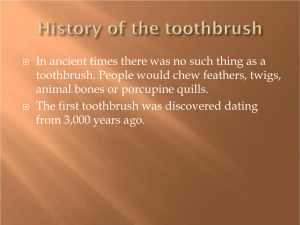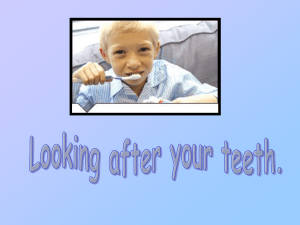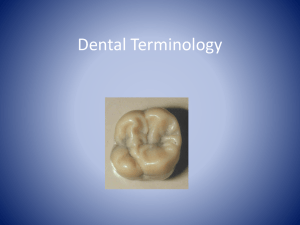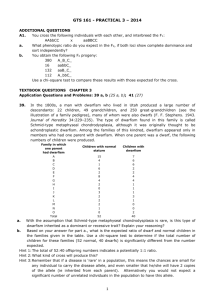Tooth Brushing
advertisement
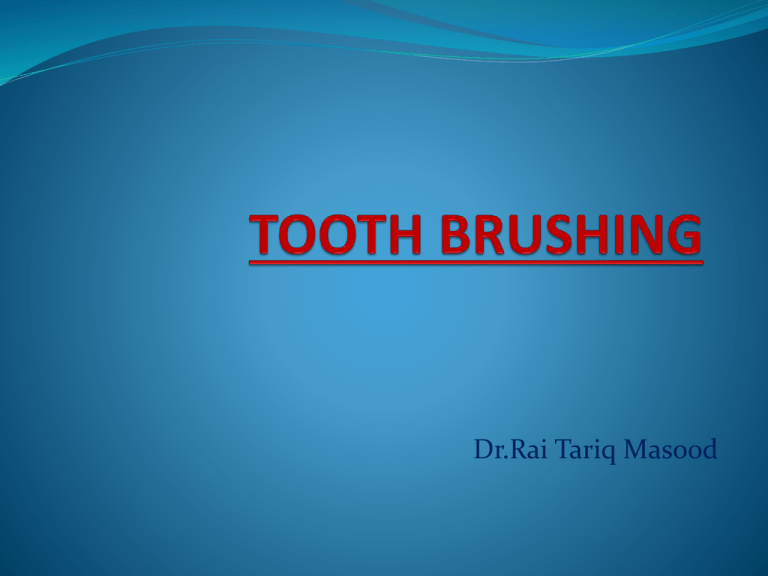
Dr.Rai Tariq Masood Tooth Brush The toothbrush is an instrument consisting of a small brush on a handle used to clean teeth through tooth brushing Act of cleaning your teeth with the tooth brush is called Tooth Brushing Tooth paste Toothpaste is a paste or gel dentifrice used with a toothbrush to clean and maintain the aesthetics and health of teeth Functions Used to promote oral hygiene Aid in the removal of dental plaque and food from the teeth on all the surfaces Elimination and/or masking of halitosis Deliver active ingredients such as fluoride or xylitol to prevent tooth and gum disease (gingivitis) To clean the tongue Amount of paste applied? Introduction The bristle tooth brush appeared 1st in china in 1600 They vary in size, design, length, hardness and arrangement of bristles Hence recommending a particular tooth brush, the ease of use by a patient as well as the perception that the brush works well are important Each brush has a Handle, a Shank and a Working end Components of a Toothbrush Handle Working end Ideal Properties of a Tooth Brush Should remove all the calculus and plaque Should access all the surfaces of the tooth Should not injure the Gingiva The bristles should be soft The bristles should not deteriorate/ or should have long working life Tooth Brush Design The bristles are grouped in Tufts Usually 3 or 4 rows of tufts Bristles are obtained from Hogs or artificially from the Nylon Two major types : manual & Electric Manual & Electric Soft and Hard Bristles Which is the better one? Force for Brushing The amount of force used is not critical for effective vigorous brushing can lead to -Gingival recession -Bacteremia -Wedge shaped defects in the cervical area of the root surface Tooth brush Trauma Techniques Stillman , Charters & Bass Modified Stillman & Bass technique Fones technique Leonard technique Scrub technique Stillman Method A toothbrushing technique that incorporates gingival stimulation and dental cleansing, in which the toothbrush is held against both the gingival and the dental surfaces and manually vibrated Continued…… The bristles ends are placed at 45 degree with the bristles directed apically on the gingiva and partly on the cervical portion of the tooth when the bristles are in position a gentle but firm vibratory motion is applied to the brush with the bristles remaining in the same position Stillman’s Modified Stillman’s Technique A occlusal stroke is also added in the movements The occlusal stroke is used after every vibratory movement. For Cleaning areas with progressing gingival recession and root exposure to minimize abrasive tissue destruction. Charter’s Method A method of toothbrushing utilizing a restricted vibratory motion with the bristles inclined coronally at a 45 degree angle. Used when the interdental gingiva does not fill the embrasure spaces Continued…… The bristles are placed at 45 degree towards the occlusal surface The bristles are placed interproximally and then vibratory movement is used while keeping the bristles in the position Charter’s Bass Method (intrasulcular) Toothbrushing technique for controlling plaque involving placement of the bristles in the sulcus at an angle of 45° to the tooth's long axis and vibrating the bristles in a quick manner from side to side Most widely accepted method for removal of plaque Continued…… The head of the tooth brush is placed parallel with the occlusal surfaces of the teeth and the bristles are directed apically into the gingival sulcus at 45 degree angle along the long axis of the tooth A firm pressure is applied in apical direction and by making short vibratory strokes. The short back-and-forth motion is easy to master. It concentrates the cleaning action on the cervical and inter-proximal portions of the teeth, where microbial plaque is most likely to have accumulated. Bass Method Modified Bass Method The modification consists of sweeping the bristles downward over the tooth surface occlusally Fone’s Technique (circular Method) A toothbrushing technique in which, with the teeth occluded and with the brush at more or less right angles to the teeth, large sweeping, scrubbing circles are described. With the jaws parted, the palatal and lingual surfaces of the teeth are scrubbed using smaller circles. Occlusal surfaces are brushed in an anteroposterior direction. Continued…… Brush is placed perpendicular to the tooth Teeth are clenched and large circular movements are given with the toothbrush Not recommended now because injury to gingiva usually occurs Leonard’s Technique A method of teeth cleaning that advocates a vigorous drawing of the toothbrush up and down across the teeth. The teeth are held apart, so that each section is brushed separately. Also known as vertical toothbrushing. Roll Method Brush is placed over the gingiva with the bristles placed apically The jaws are separated The bristles are pressed against the gingiva and with continued pressure the brush is slowly rolled down over the surface of gingiva and tooth by rotating the wrist Continued…… Most easy method But the gingival sulcus may not be cleaned by this Horizontal scrub Method The bristles are placed 90⁰ to the tooth and move horizontally. Most widely used method but not recommended. Can cause gingival recession. Brushing the Occlusal Surface The bristles are placed at right angle on the occlusal surface with the ends of the bristles deep into the pits and fissures Vibrate the brush while keeping in the same area Next give it the circular movements Occlusal Brushing Brushing the Tongue Place the bristles at a right angle to the tongue Apply pressure on the tongue and give to and fro movements Mouth Rinsing Very important Done to flush away the debris that was loosened but not removed Water or Mouth wash Introduction Simple toothbrushing cannot clean all the surfaces For ideal plaque removal certain aids must be supplemented which assist in cleaning the remaining portions Dental floss Interdental toothbrushes Mouth washes Disclosing tablets and solutions Dentifrices Dental Floss Continued…… Slowly push the floss interdentally, Don’t force it otherwise gingival trauma may occur Start from the base of gingival sulcus Move in up & down motion Move along the tooth surface Do it slowly to avoid trauma Flossing technique Interdental Brush Usage Disclosing tablets & Solutions Disclosed plaque

